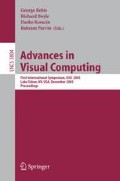Abstract
The Ambient Intelligence (AmI) paradigm requires a robust interpretation of people actions and behaviour and a way for automatically generating persistent spatial-temporal models of recurring events. This paper describes a relatively inexpensive technique that does not require the use of conventional trackers to identify the main paths of highly cluttered scenes, approximating them with spline curves. An AmI system could easily make use of the generated model to identify people who do not follow prefixed paths and warn them. Security, safety, rehabilitation are potential application areas. The model is evaluated against new data of the same scene.
Access this chapter
Tax calculation will be finalised at checkout
Purchases are for personal use only
Preview
Unable to display preview. Download preview PDF.
References
Makris, D., Ellis, T.: Learning semantic scene models from observing activity in visual surveillance. IEEE Transactions on Systems Man and Cybernetics - Part B 35, 397–408 (2005)
Brand, M.: Learning concise models of visual activity. Technical Report TR1997-025, MERL (1997)
Buzan, D., Sclaroff, S., Kollios, G.: Extraction and clustering of motion trajectories in video. In: Proceedings of the 17th International Conference on Pattern Recognition, vol. 2, pp. 521–524 (2004)
Still, K.: Crowd Dynamics. PhD thesis, University of Warwick (2000)
Helbing, D., Buzna, L., Johansson, A., Werner, T.: Self-organised pedestrian crowd dynamics: experiments, simulations and design solutions. Transportation Science 39, 1–24 (2005)
Helbing, D., Farkas, I., Vicsek, T.: Simulating dynamical features of escape panic. Nature 407, 487–490 (2000)
Musse, S., Thalmann, D.: Hierarchical model for real time simulation of virtual human crowds. IEEE Transactions on Visualization and Computer Graphics 7, 152–164 (2001)
Stauffer, C., Grimson, W.E.L.: Adaptive background mixture models for real-time tracking. In: IEEE Computer Society Conference on Computer Vision and Pattern Recognition, vol. 2, pp. 23–25 (1999)
Stauffer, C., Grimson, W.E.L.: Learning patterns of activity using real-time tracking. IEEE Transactions on Pattern Analysis and Machine Intelligence 22, 747–757 (2000)
Sonka, M., Hlavac, V., Boyle, R.: Image Processing: Analysis and Machine Vision, 2nd edn. Thomson Learning Vocational (1998)
Sutton, S., Barto, A.G.: Reinforcement Learning: an Introduction. MIT Press, Cambridge (1998)
Author information
Authors and Affiliations
Editor information
Editors and Affiliations
Rights and permissions
Copyright information
© 2005 Springer-Verlag Berlin Heidelberg
About this paper
Cite this paper
Zhan, B., Remagnino, P., Velastin, S.A. (2005). Mining Paths of Complex Crowd Scenes. In: Bebis, G., Boyle, R., Koracin, D., Parvin, B. (eds) Advances in Visual Computing. ISVC 2005. Lecture Notes in Computer Science, vol 3804. Springer, Berlin, Heidelberg. https://doi.org/10.1007/11595755_16
Download citation
DOI: https://doi.org/10.1007/11595755_16
Publisher Name: Springer, Berlin, Heidelberg
Print ISBN: 978-3-540-30750-1
Online ISBN: 978-3-540-32284-9
eBook Packages: Computer ScienceComputer Science (R0)

